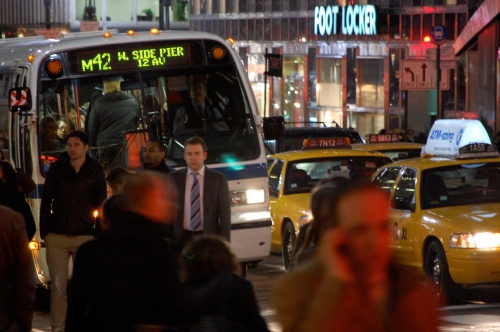These faces in the crowd
In the Hoyt-Schermerhorn subway station in Brooklyn this afternoon, a very handsome boy in his late teens or early twenties was leaning back against an iron beam next to the tracks. He was dressed fashionably, in an army-green jacket with red chevrons on the shoulders and skinny navy-blue jeans that rode below his hips. Like a model in a fashion spread, he looked world-weary and sophisticated, until I imagined him in the age-appropriate clothing of normal teenage style, at which point he just looked bored. In fact, he seemed to be falling asleep. His eyes were closed and his head would loll and occasionally jolt, in the motion of an involuntary nap. I found an iron beam of my own to lean against and began to read.
When I looked up from my book, he was crossing the platform towards me. Something was wrong. His head was still pitched slightly backward, and his eyelids were mostly closed, one slit just wider than the other. His arms hung limply at his sides. Each time his foot struck the ground he would pause, as if to secure his balance and calibrate the distance of his next stride. I assume he was on heroin. The vacant stare, the zombie gait, the high sloping cheekbones and soft, pale complexion — I felt repulsed. I thought of the uncanny valley, a term in robotics that describes the sense of revulsion people feel towards very close yet imperfect facsimiles of humans.
Step by step he approached. There were train tracks at my back, and I wondered — in a moment that pitted self-preservation against modest heroics — whether I should step aside and let him pass to the ledge or stand in his way. Four paces away, three, two. I stood. At the last moment, he veered sideways and plodded back towards the other side of the platform.
I looked around as you do when something strange happens and you want an empathetic nod from a fellow stranger. There were a hundred people or more within view, but most hadn’t seen the boy, or had pretended not to see. One woman, blond, in a business suit, in her forties, craned her neck around me and watched, with a look of both consternation and concern, as the boy, now ten paces away from us, walked right up to the ledge of the Queens-bound G track.
A voice on the loudspeaker said, “There is a Queens-bound G train approaching the station.”
It’s amazing how many things you can think about at once in a moment of crisis. I noticed the cigarette behind the boy’s right ear. I wondered whether this might be a piece of performance art. I recalled a New Year’s Eve in Venice when, standing on a water taxi platform, I watched an old man in a tuxedo fall into the Canal Grande and, as I stood inertly thinking that I should jump in after him, some men reached belly- down over the ledge, grabbed his arm, and pulled him from the water. I told myself I should not intervene here, since if this boy should jump, then he had chosen his fate, and if he should fall, he had earned it. Then I reprimanded myself, telling myself that this boy was dear to someone — a mother, a little brother — even if he was not dear to himself. Then I reminded myself that if anyone living in such a city as New York were to imagine the texture of every other life he encountered, his heart would crack. A dozen more thoughts, too, as the boy swayed unsteadily and caught himself with a stiff shuffle.
A rumbling of wheels and a screech of old metal announced the arrival of a train into the station. It was the C train, on the other track behind me, arriving ahead of the fateful G. I felt my body loosen with relief. Either line would take me home.
